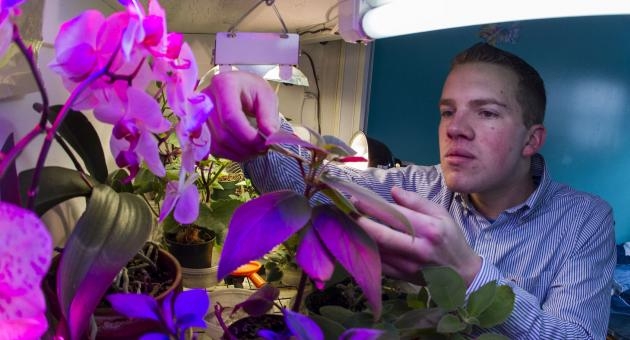Senior horticulture major finds beauty in the macabre

Brandon Huber is no stranger to success at the Pennsylvania Horticultural Society’s Philadelphia Flower Show.
In the eight years that he has been showing off the best of his ever-growing — and admittedly weird — menagerie of plants at the Flower Show’s “Horticourt,” he has amassed more ribbons than he has wall space, surpassing 250 after continued good fortune at the 2013 show.
But, you won’t find any orchids or typical blooming buds among his entries. Huber, 23, is always looking for the “showstopper.” His first-class entries for 2013 include a hanging begonia of monstrous proportions; a climbing onion — an onion growing on the soil surface “with a crazy vine growing out of it;” and a variegated ivy that he has trained to grow in a circle.
And that’s just the tip of the leafy green iceberg for Huber’s collection of more than 300 plants.
“The Horticourt has some of the most diverse, exotic and unusual plants that you’re likely to see anywhere — I knew I wanted to be a part of it,” said Huber, a senior Horticulture major in the Department of Landscape Architecture and Horticulture, part of Temple’s School of Environmental Design, who is also Student Government president at the Ambler Campus. “I thrive on the challenge of it and the chance to push the plants to their limit; to see what I can do.”
His crowning achievement, so far, has been a Best in Show Award in 2009 for his “amorphophallus konjac,” a massive six-foot tall, dark purple nightmare that feels like vinyl and has one of the largest flowers in the world. It’s more common and colorful name is “corpse plant,” an appellation it lives up to by giving off a stench of rotting meat when in full bloom that could fell an unsuspecting nose from 100 feet away. One of the plant’s offspring won a first place ribbon at this year’s show during the second judging day.
“The amorphophallus smells just like a dead body! It’s actually a pollinating technique; just like other flowers use nice smells to attract bees and butterflies. The corpse plant attracts carrion beetles and house flies — anything that would be attracted to road kill,” he said. “It really stinks up the show — you’d think people would be repelled by it, but they can’t get enough of it.”
Huber’s corpse plants are not alone in the “just plain weird” category of his collection. They are joined by more than 100 cacti and succulents — some in shapes and sizes that would look at home on any alien planet — and pumpkins that weigh in at hundreds of pounds each.
Then there are the carnivores, more than 30 Venus flytraps, long throated pitcher plants, and sticky tentacled sundews that thrive not on sunshine and soil but on live meat.
“The flytraps are native to the Carolinas. They live in bogs, which are very anaerobic environments, very poor in nutrients. They evolved to feed themselves. Huber said. “You can actually watch them move to catch things — it’s like watching a predator. While it’s mostly insects they’ll occasionally catch frogs and even small lizards.”
“Most plants just want soil, water and sun, but these attract ‘prey’ chemically and physically,” said Anne Brennan, Horticulture Supervisor for the Ambler Arboretum of Temple University. “People love the novelty of it. We often use carnivorous plants in our Flower Show exhibits because they winter well and they look great.”
Huber said carnivorous plants don’t, however, tend to be the belle of the ball at the Flower Show.
“Sometimes, I think, some of the judges are a little put off by them,” he said. “Some of these are scary looking plants — some look like they have fangs! When you think about a plant devouring meat, that creeps some people out.”